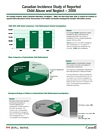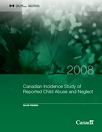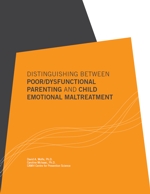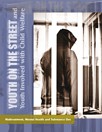Common menu bar links
Child Abuse and Neglect
 Canadian Incidence Study of Reported Child Abuse and Neglect - 2008 Fact Sheet
Canadian Incidence Study of Reported Child Abuse and Neglect - 2008 Fact Sheet
by the Public Health Agency of Canada (PHAC)
PDF
The CIS-2008 Fact Sheet summarizes the major descriptive findings from the third cycle of the Canadian Incidence Study of Reported Child Abuse and Neglect. 2010, 1p. HP5-1/1-2008E

Canadian Incidence Study of Reported Child Abuse and Neglect - 2008 Major Findings
by the Public Health Agency of Canada (PHAC)
HTML - PDF
The CIS-2008 Major Findings Report presents the major descriptive findings from the third cycle of the Canadian Incidence Study of Reported Child Abuse and Neglect. The chapters look at incidence estimates of abuse and neglect, maltreatment characteristics, child characteristics, household characteristics, referral characteristics, and a comparison of results between the current cycle and the previous cycles. 2010, 105p. HP5-1/2008E

Canadian Incidence Study of Reported Child Abuse and Neglect - 2003 Major Findings
by Nico Trocmé et al.
PDF
The Canadian Incidence Study of Reported Child Abuse and Neglect (CIS) is the core national child maltreatment surveillance activity of the Public Health Agency of Canada. This is the report of the major findings of the second cycle of the CIS (CIS-2003). The primary objective is to provide reliable estimates of the scope and characteristics of reported child abuse and neglect. The CIS-2003 addresses the five principal forms of maltreatment: physical abuse, sexual abuse, neglect, emotional maltreatment and exposure to domestic violence. 2005, 160p. HP5-1-2005E

Child Maltreatment in Canada - Overview Paper
by Susan Jack, RN, PhD, Catharine Munn, MD, FRCP(C), Chiachen Cheng, MD, MPH, FRCP(C), and Harriet MacMillan, MD, MSc, FRCP(C)
PDF
As an update of the Child Abuse & Neglect Overview Paper (1997), this paper highlights the epidemiology of child maltreatment, including incidence, prevalence and correlates, based predominantly on, but not limited to, Canadian research and data. Newly released data from studies such as the Canadian Incidence Study of Reported Child Abuse and Neglect-2003 are highlighted. The paper concludes with a list of references, resources and contact information for individuals requiring further information about child maltreatment. 2006, 13 p. HP20-2-2006E
Child Maltreatment and Alcohol
by the World Health Organization and John Moores University, Centre for Public Health
PDF
This fact sheet details the role of harmful alcohol consumption in child maltreatment, its lifelong impact on alcohol use patterns in people who are maltreated as children, and the role of public health in prevention. H72-01-10E

Child Maltreatment - A "What to Do" Guide for Professionals Who Work With Children
by Chiachen Cheng, MD, MPH, FRCP(C), Catharine Munn, MD, FRCP(C), Susan Jack, RN, PhD and Harriet MacMillan, MD, MSc, FRCP(C)
PDF
This overview paper highlights evidence-based interventions for child maltreatment. Sections include signs and symptoms of maltreatment, reporting and legal implications, prevention and intervention approaches, and what practitioners can do if they suspect or receive a disclosure of child maltreatment. The paper concludes with a list of key references, resources and contact information for individuals requiring further information. 2006, 16 p. HP10-10-2006E

Distinguishing between poor/dysfunctional parenting and child emotional maltreatment
by David A. Wolfe, Ph.D. and Caroline McIsaac, Ph.D. (CAMH Centre for Prevention Science)
HTML - PDF
This research paper explores the similarities and differences between poor parenting and child emotional maltreatment. It reviews various parenting styles, risk factors for child emotional maltreatment, and makes suggestions for future work in this area. 2010, 31p. HP20-16/2010E-PDF
Preventing Child Maltreatment: A guide to taking action and generating evidence
by the World Health Organization and International Society for Prevention of Child Abuse and Neglect
PDF
This guide is intended to assist governments, research institutes and NGOs to design and deliver programs for the prevention of child maltreatment by parents and caregivers. It provides technical advise on how to measure the extent of child maltreatment and its consequences; how to design, implement and evaluate prevention programs, and on important considerations for detecting and responding to child maltreatment. 2006, 90 p. H72-01-8E
 Raising Today’s Teens: Why Parents Matter
Raising Today’s Teens: Why Parents Matter
by National Clearinghouse on Family Violence
PDF
This overview paper describes some of the challenges in parent-teen relationships and provides guidance for parents of teens. It also describes changes that are experienced by teenagers and demonstrates how some of these changes influence their behaviour. The overview paper also acknowledges a parent's need for support by identifying sources of help and suggested reading material and websites. HP20-13-2008E
Unicef Posters

Children Learn by Example
by UNICEF
PDF
A poster on violence against children in the media developed by youth for youth. H72-01-4

Doing Nothing Is Doing Everything
by UNICEF
PDF
A poster on violence against children with a focus on bullying developed by youth for youth. H72-01-5

Caught in the Middle
by UNICEF
PDF
A poster on violence against children in families developed by youth for youth. H72-01-6

Membership Has its Privileges
by UNICEF
PDF
A poster on violence against children in communities developed by youth for youth. H72-01-7
Up Against A Wall: Coping with Becoming a Teen When You Have Been Maltreated As a Child
by Wekerle C, Leung E, Goldstein A, Thornton T, Tonmyr L. (2009)
HTML - PDF
The likelihood of substance use problems in adolescence increases with several risk factors, including child maltreatment. A collaborative initiative led by the ORS with researchers from the University of Western Ontario and the Public Health Agency of Canada undertook a comparative analysis that provides the rates of substance abuse amongst youth involved in child welfare vs. the general population.
Results show that youth involved in child welfare report higher use of cannabis and other drugs. Females are especially at risk reporting greater cannabis and other drug use in their lifetime as well as frequent drug use. Types of maltreatment, except sexual abuse, were linked with substance abuse patterns, which varied according to those who provided the maltreatment history. Strategic policy and practice implications are identified. HP5-81-2009
 Youth on the Street and Youth Involved with Child Welfare: Maltreatment, Mental Health and Substance Use
Youth on the Street and Youth Involved with Child Welfare: Maltreatment, Mental Health and Substance Use
by Abby L. Goldstein,
Touraj Amiri,
Natalie Vilhena,
Christine Wekerle,
Tiffany Thornton and
Lil Tonmyr
PDF
This study looks at a number of factors related to mental health and substance use in three groups of youth in Canada: those currently in child welfare; youth who are homeless with previous involvement in child welfare, and youth who are homeless who had never been involved in child welfare. 2011, 58 p.
Youth Violence and Alcohol
by the World Health Organization and John Moores University, Centre for Public Health
PDF
This fact sheet summarizes the role of alcohol and youth violence, the magnitude of the problem, risk factors for involvement in alcohol-related youth violence, prevention measures and the role of public health.H72-01-13E





To share this page just click on the social network icon of your choice.